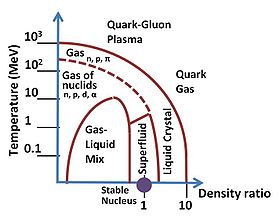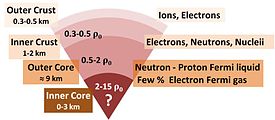- Nuclear matter
-
Phases of nuclear matter with equal numbers of neutrons and protons; Compare with Siemens & Jensen.[1]

Nuclear matter is an idealized system of interacting nucleons (protons and neutrons) that exists in several phases that as yet are not fully established.[2] It is not matter in a nucleus, but a hypothetical substance consisting of a huge number of protons and neutrons interacting by only nuclear forces and no Coulomb forces.[3][4]Volume and the number of particles are infinite, but the ratio is finite.[5] Infinite volume implies no surface effects and translational invariance (only differences in position matter, not absolute positions).
A common idealization is symmetric nuclear matter, which consists of equal numbers of protons and neutrons, with no electrons.
When nuclear matter is compressed to sufficiently high density, it is expected, on the basis of the asymptotic freedom of Quantum chromodynamics, that it will become quark matter, which is a degenerate Fermi gas of quarks.[6]
Cross-section of neutron star. Densities are in terms of ρ0 the saturation nuclear matter density, where nucleons begin to touch. Patterned after Haensel et al.,[7] page 12
Some authors use "nuclear matter" in a broader sense, and refer to the model described above as "infinite nuclear matter",[1] and consider it as a "toy model", a testing ground for analytical techniques.[8] However, the composition of a neutron star, which requires more than neutrons and protons, is not necessarily locally charge neutral, and does not exhibit translation invariance, often is differently referred to, for example, as neutron star matter or stellar matter and is considered distinct from nuclear matter.[9][10] In a neutron star, pressure rises from zero (at the surface) to an unknown large value in the center.
Methods capable of treating finite regions have been applied to stars and to atomic nuclei.[11][12] One such model for finite nuclei is the liquid drop model, which includes surface effects and Coulomb interactions.
References
- ^ a b Phillip John Siemens, Aksel S. Jensen (1994). Elements Of Nuclei: Many-body Physics With The Strong Interaction. Westview Press. ISBN 0201627310. http://books.google.com/?id=z-8vuyAqT9MC&pg=PA347.
- ^ Dominique Durand, Eric Suraud, Bernard Tamain (2001). Nuclear dynamics in the nucleonic regime. CRC Press. p. 4. ISBN 0750305371. http://books.google.com/?id=9obAY54qb30C&pg=PA4.
- ^ Richard D. Mattuck (1992). A Guide to Feynman Diagrams in the Many-body Problem (Reprint of 1974 McGraw-Hill second ed.). Courier Dover Publications. ISBN 0486670473. http://books.google.com/?id=pe-v8zfxE68C&pg=PA92.
- ^ John Dirk Walecka (2004). Theoretical nuclear and subnuclear physics (2 ed.). World Scientific. p. 18. ISBN 9812388982. http://books.google.com/?id=mfphXc8b-2IC&pg=PA18.
- ^ Helmut Hofmann (2008). The Physics of Warm Nuclei: With Analogies to Mesoscopic Systems. Oxford University Press. p. 36. ISBN 0198504012. http://books.google.com/?id=JIX5bIkQks0C&pg=PA36.
- ^ Stefan B Rüster (2007). "Phase diagram of neutral quark matter at moderate densities". In Armen Sedrakian, John Walter Clark, Mark Gower Alford. Pairing in fermionic systems. World Scientific. ISBN 9812569073. http://books.google.com/?id=HlW_DXqKvLUC&pg=PA19.
- ^ Paweł Haensel, A Y Potekhin, D G Yakovlev (2007). Neutron Stars. Springer. ISBN 0387335439. http://books.google.com/?id=iIrj9nfHnesC&printsec=frontcover#PPA12,M1.
- ^ Herbert Müther (1999). "Dirac-Brueckner approach for finite nuclei". In Marcello Baldo. Nuclear methods and the nuclear equation of state. World Scientific. p. 170. ISBN 9810221657. http://books.google.com/?id=e3xeCXHJq6wC&pg=PA170.
- ^ Francesca Gulminelli (2007). "Nuclear matter versus stellar matter". In A. A. Raduta, V. Baran, A. C. Gheorghe, I. Ursu. Collective Motion and Phase Transitions in Nuclear Systems. World Scientific. ISBN 9812700838. http://books.google.com/?id=lQVw1Sh6XcgC&pg=PA392.
- ^ Norman K. Glendenning (2000). Compact stars (2 ed.). Springer. p. 242. ISBN 0387989773. http://books.google.com/?id=BBSOgxe2S1AC&pg=PA242.
- ^ F. Hofmann, C. M. Keil, H. Lenske (2001). "Density dependent hadron field theory for asymmetric nuclear matter and exotic nuclei". Phys Rev C (Nuclear Physics) 64. arXiv:nucl-th/0007050. Bibcode 2001PhRvC..64c4314H. doi:10.1103/PhysRevC.64.034314.
- ^ A. Rabhi, C. Providencia, J. Da Providencia (2008). "Stellar matter with a strong magnetic field within density-dependent relativistic models". J Phys G: Nucl Part Phys 35: 125201. arXiv:0810.3390. Bibcode 2008JPhG...35l5201R. doi:10.1088/0954-3899/35/12/125201.
See also
- QCD vacuum
- Quark-gluon plasma
- Degenerate matter
- Neutron-degenerate matter
- Strange matter
- Nuclear structure
- Neutronium
- Nuclear physics
Categories:- Nuclear physics
- Phases of matter
- Physics stubs
Wikimedia Foundation. 2010.


